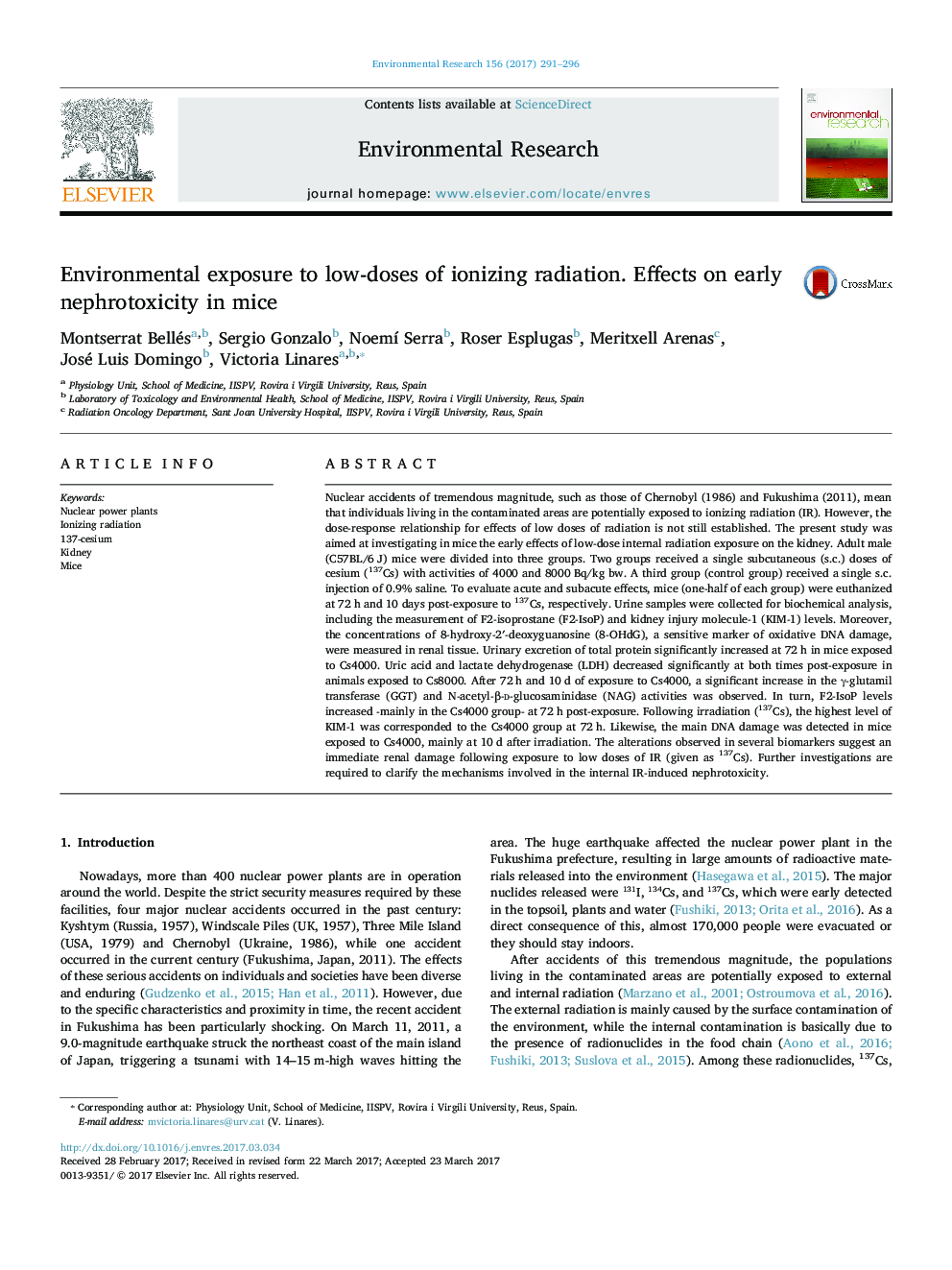| کد مقاله | کد نشریه | سال انتشار | مقاله انگلیسی | نسخه تمام متن |
|---|---|---|---|---|
| 5756486 | 1622547 | 2017 | 6 صفحه PDF | دانلود رایگان |
عنوان انگلیسی مقاله ISI
Environmental exposure to low-doses of ionizing radiation. Effects on early nephrotoxicity in mice
ترجمه فارسی عنوان
قرار گرفتن در معرض زیست محیطی با کم شدن دوز تابش یونیزه. اثرات عصب شناسی اولیه در موش سوری
دانلود مقاله + سفارش ترجمه
دانلود مقاله ISI انگلیسی
رایگان برای ایرانیان
کلمات کلیدی
نیروگاه های هسته ای، تابش یونیزه، 137 سزیم، کلیه، موش،
موضوعات مرتبط
علوم زیستی و بیوفناوری
علوم محیط زیست
بهداشت، سم شناسی و جهش زایی
چکیده انگلیسی
Nuclear accidents of tremendous magnitude, such as those of Chernobyl (1986) and Fukushima (2011), mean that individuals living in the contaminated areas are potentially exposed to ionizing radiation (IR). However, the dose-response relationship for effects of low doses of radiation is not still established. The present study was aimed at investigating in mice the early effects of low-dose internal radiation exposure on the kidney. Adult male (C57BL/6 J) mice were divided into three groups. Two groups received a single subcutaneous (s.c.) doses of cesium (137Cs) with activities of 4000 and 8000 Bq/kg bw. A third group (control group) received a single s.c. injection of 0.9% saline. To evaluate acute and subacute effects, mice (one-half of each group) were euthanized at 72 h and 10 days post-exposure to 137Cs, respectively. Urine samples were collected for biochemical analysis, including the measurement of F2-isoprostane (F2-IsoP) and kidney injury molecule-1 (KIM-1) levels. Moreover, the concentrations of 8-hydroxy-2â²-deoxyguanosine (8-OHdG), a sensitive marker of oxidative DNA damage, were measured in renal tissue. Urinary excretion of total protein significantly increased at 72 h in mice exposed to Cs4000. Uric acid and lactate dehydrogenase (LDH) decreased significantly at both times post-exposure in animals exposed to Cs8000. After 72 h and 10 d of exposure to Cs4000, a significant increase in the γ-glutamil transferase (GGT) and N-acetyl-β-D-glucosaminidase (NAG) activities was observed. In turn, F2-IsoP levels increased -mainly in the Cs4000 group- at 72 h post-exposure. Following irradiation (137Cs), the highest level of KIM-1 was corresponded to the Cs4000 group at 72 h. Likewise, the main DNA damage was detected in mice exposed to Cs4000, mainly at 10 d after irradiation. The alterations observed in several biomarkers suggest an immediate renal damage following exposure to low doses of IR (given as 137Cs). Further investigations are required to clarify the mechanisms involved in the internal IR-induced nephrotoxicity.
ناشر
Database: Elsevier - ScienceDirect (ساینس دایرکت)
Journal: Environmental Research - Volume 156, July 2017, Pages 291-296
Journal: Environmental Research - Volume 156, July 2017, Pages 291-296
نویسندگان
Montserrat Bellés, Sergio Gonzalo, Noemà Serra, Roser Esplugas, Meritxell Arenas, José Luis Domingo, Victoria Linares,
